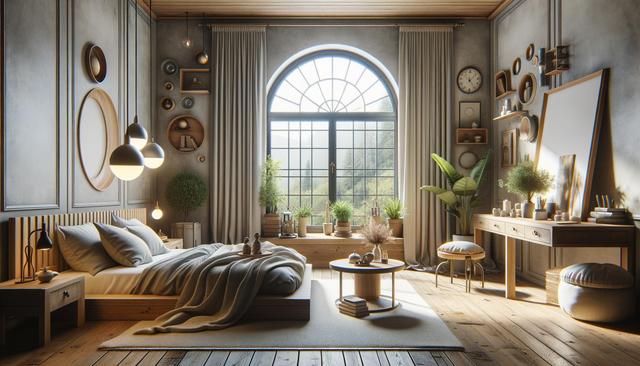Balancing Light Control and Aesthetic Appeal
Window treatments play a crucial role in managing natural light while enhancing the overall style of your living space. From sleek, modern interiors to homes with a more traditional design, the right window covering can transform how a room feels and functions. Light control is one of the main purposes of window treatments, allowing homeowners to adjust the brightness and ambiance of a room throughout the day. By choosing the appropriate materials and designs, such as layered fabrics or adjustable slats, it becomes possible to filter sunlight, reduce glare, or completely darken a room for optimal comfort.
Some popular window treatment options for managing light include:
- Sheer curtains: Ideal for diffusing natural light while maintaining a soft, airy look.
- Blinds with adjustable slats: Provide precise control over the amount and direction of light entering a room.
- Blackout shades: Designed to block external light entirely, perfect for bedrooms or media rooms.
Choosing window treatments that balance style and function ensures that your space remains both visually appealing and comfortable throughout the day.
Enhancing Privacy Without Sacrificing Design
Privacy is another essential consideration when selecting window treatments, particularly in urban or densely populated areas where homes are closely spaced. The right window treatment can help shield your interiors from prying eyes while still allowing natural light to enter. Achieving this balance often involves selecting materials and styles that offer flexibility, such as dual-layer shades or top-down/bottom-up options that provide coverage where it’s most needed.
Here are a few options that support privacy without compromising design:
- Frosted window films: Offer discreet coverage while still letting in light.
- Roman shades: Combine fabric elegance with the ability to adjust coverage levels easily.
- Cafe curtains: Cover the lower part of the window, allowing light in through the top while maintaining privacy at eye level.
When privacy and aesthetics are both prioritized, window treatments become an integral part of a thoughtfully designed interior space.
Material Choices and Their Functional Benefits
The material of your window treatment significantly impacts its functionality and visual appeal. Natural fabrics like cotton or linen offer a casual, breathable look, while heavier materials like velvet or jacquard add luxury and better insulation. Synthetic blends can often provide a more durable and stain-resistant option, especially in high-traffic areas or homes with children and pets.
Each material comes with its own set of advantages:
- Natural fabrics: Soft texture, eco-friendly, and breathable.
- Heavyweight textiles: Enhanced insulation, sound dampening, and light-blocking features.
- Synthetic fabrics: Durable, easy to clean, and available in a wide range of colors and patterns.
Understanding the properties of each fabric type can help you make informed decisions based on your room’s needs, climate, and overall design goals.
Layering Techniques for Style and Function
Layering different types of window treatments is a strategic way to enhance both form and function. By combining elements like sheer panels with thick drapes or pairing blinds with valances, you can create a dynamic look that adapts to changing light and privacy needs throughout the day. This approach also allows for greater flexibility in design, enabling you to switch between open, airy settings and cozy, enclosed environments with ease.
Some effective layering combinations include:
- Sheer curtains beneath blackout drapes for day-to-night versatility.
- Wooden blinds paired with soft fabric valances for a rustic yet refined touch.
- Roller shades with side panels to add color and texture to minimalist rooms.
Layering also provides an opportunity to introduce different colors, materials, and patterns into your interior, enriching the visual narrative of your living space.
Custom vs. Ready-Made Window Treatments
When choosing window treatments, one important decision is whether to go with custom-made options or ready-made solutions. Custom treatments are tailored to fit your specific window dimensions and design preferences, offering a more personalized result. They often allow for a wider range of materials, finishes, and functionalities. Ready-made treatments, on the other hand, offer a quicker and often more affordable solution, with many versatile styles available that can fit standard window sizes.
Factors to consider when choosing between custom and ready-made include:
- Budget: Custom options tend to be more expensive due to their bespoke nature.
- Timeframe: Ready-made treatments are readily available and can be installed quickly.
- Design needs: Custom solutions offer more flexibility for unique windows or specific aesthetic goals.
Both options have their merits, and your choice may depend on how much importance you place on fit, customization, and overall design coherence within your space.
Conclusion: Finding the Right Balance for Your Home
Choosing window treatments is about more than just covering a window; it’s an opportunity to enhance your home’s functionality and visual appeal. By carefully considering factors like light control, privacy, material, style, and customization, you can find solutions that complement your interior while addressing your practical needs. Whether you’re updating a single room or redesigning an entire home, thoughtful window treatments contribute significantly to the comfort and atmosphere of your living space. Take your time exploring options, and you’ll be rewarded with a home that feels both stylish and well-suited to your daily life.




Leave a Reply